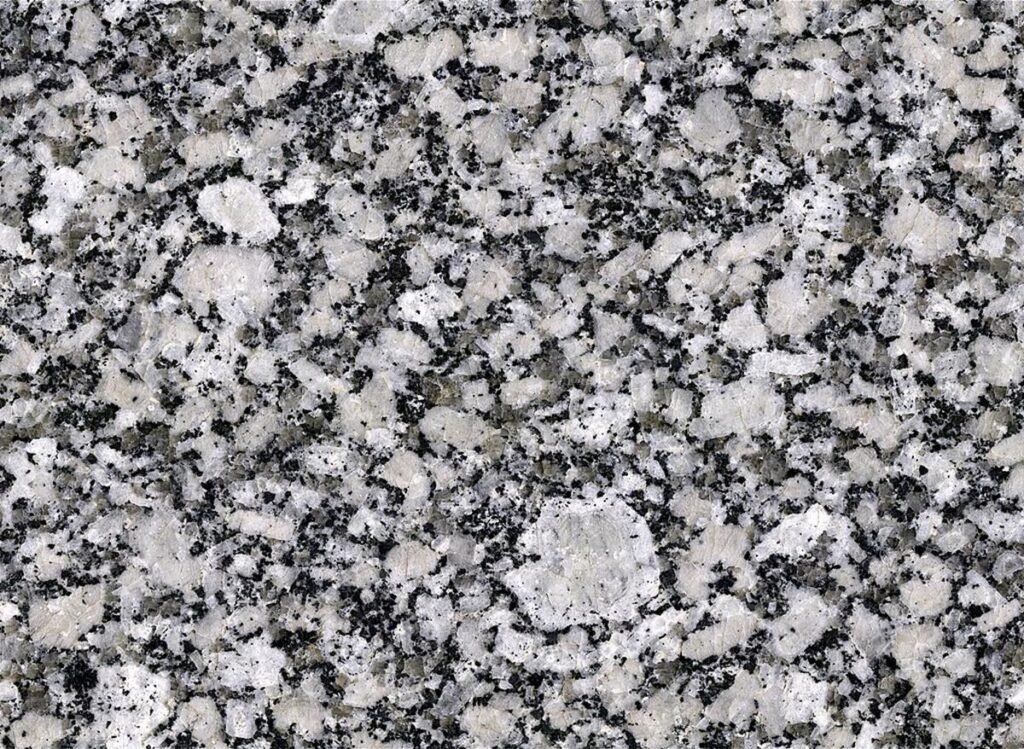Porphyritic granite has large, well-formed white or pink alkali feldspar and sometimes quartz, biotite, or plagioclase in a finer but phaneritic matrix.
The matrix has mostly alkali feldspar, plagioclase, and quartz with minor amphibole, mica, muscovite, other mafic minerals, and accessory minerals.
Common accessory minerals are apatite, titanite, topaz, magnetite, garnet, monazite, allanite, etc.
Usually, the large, well-formed minerals are called phenocrysts, while the finer but phaneritic matrix is groundmass.
Porphyritic or phyric (US) is an adjective from the noun porphyry or phyre (US). It describes rocks with bimodal grain sizes, i.e., distinctively large grains surrounded by finer grains. The finer grains can have fine, medium, or coarse grain sizes.
You can also suffix the word porphyry with the rock composition name. In this respect, this rock will also be known as a granite porphyry.


Note: Rapakivi granites are porphyritic granites. They have large, oval to nearly rounded pink or reddish feldspar phenocryst set in a finer-grained groundmass. However, in Rapakivi granites, the phenocryst is rimmed with sodium-rich plagioclase.
How does porphyritic granite
The most common way that porphyritic rocks form is via the two-staged cooling process. A slower stage forms the larger, well-formed crystals, and a faster stage forms the finer-grained groundmass.
However, this isn’t how granite porphyries form. Why? Because they crystallize deep inside the Earth’s crust, where cooling is relatively uniform.
How else can you explain their formation? There are two possible explanations, i.e., the phenocrysts formed from crystals formed outside eutectic composition, or there were different nucleation and crystal growth rates.
1. Crystallization started outside the eutectic composition
Minerals with higher melting points can start crystalizing before the mixture reaches eutectic composition. Eutectic composition refers to a homogenous solution with a temperature lower than any constituent component.
Such minerals will have large, well-formed crystals that grow unimpeded, forming phenocrysts.
As cooling continues, the uncrystallized material will reach the eutectic composition, where various minerals crystalize, forming the groundmass.
Groundmass will have smaller mineral grains that aren’t well-formed compared to phenocrysts. This happens as minerals crystallize and impede each other’s growth.
Difference in nucleation and crystal growth rate
A more probable way porphyritic granite forms is where minerals have different rates of nucleation and growth of crystals.
For instance, the well-formed alkali feldspar phenocrysts nucleate at lower rates but grow faster above solidus temperature. This will allow their crystals to grow larger compared to other mineral grains.
In granitic magmas, quartz and feldspar will reach saturation a few to tens of degrees above solidus temperature. More than 50% of the magma will still be liquid since alkali feldspar and quartz have high solubilities.
This means that they will have sufficient space to grow large crystals. Sometimes, such minerals can form during the late crystallization stage, not earlier.
Where are they found?
Porphyritic granite is typical in orogenic zones with considerable rifts and hotspots. They occur as sills, dikes, stocks, batholiths, laccoliths, or lopoliths.
Examples in the US include the Sierra Nevada, Peninsula Range Batholith, Basin and Range province, and the Appalachians.
A famous example in the US is Meredith porphyritic granite found around Meredith in New Hampshire. It has up to 2 inches of phenocrysts of feldspar, usually white orthoclase, in a groundmass of feldspar, quartz, biotite, and muscovite. Some samples have garnet and sillimanite.
However, the so-called red granite porphyry is a dacite to trachyandesite rock mined in Egypt, popular during the antiquity age. The Romans and Byzantines highly valued it and was known as the Roman Imperial porphyry.
Uses of granite porphyry
Porphyritic granite uses include making aggregate or dimensional stones, while some are associated with valuable ore deposits.
These rocks are crushed and used in roading as railway ballast, fill, subbases, etc. Also, you can use the gravel on unpaved driveways, walkways, or patios.
In dimension stone industries, they are cut and polished to make kitchen countertops, tiles, cabinet tops, windowsills, stair treads, tiles, worktops, etc. They also make statues, monuments, memorials, and headstones.
That is not all. Varieties like Rapakivi granites are valued facing stones in Europe and other places worldwide.
Lastly, some porphyry copper and molybdenum deposits are associated with porphyritic granites. Also, they can have other minerals such as iron, silver, gold, and tin.
